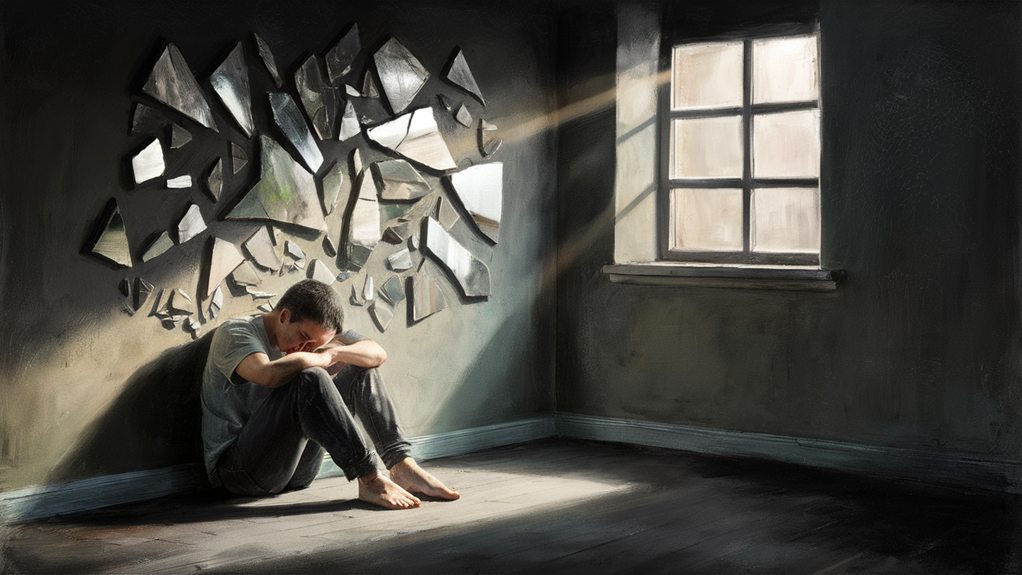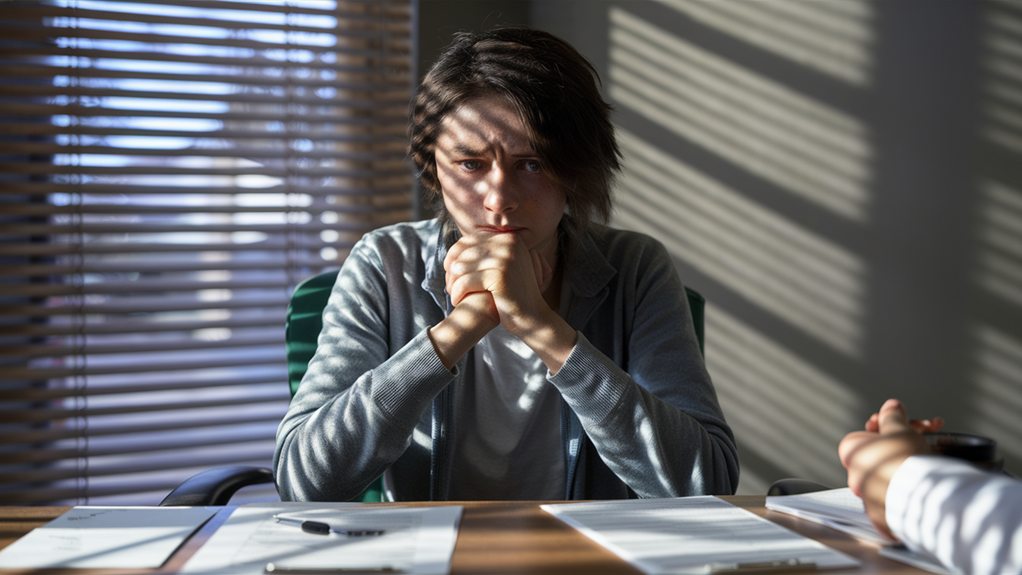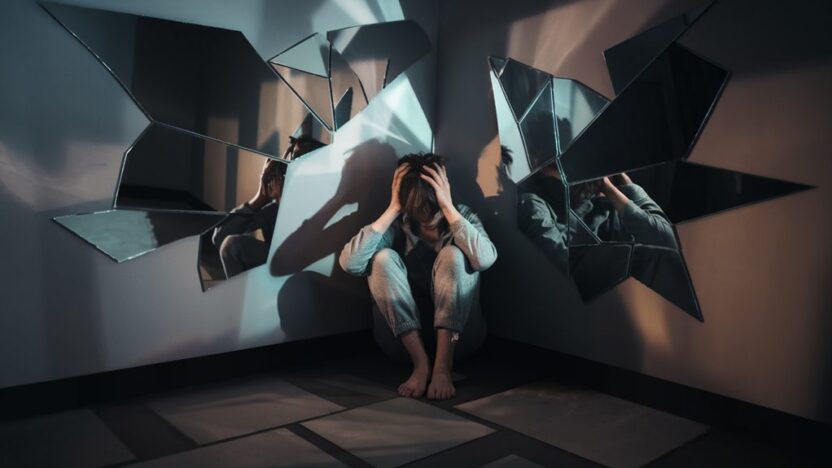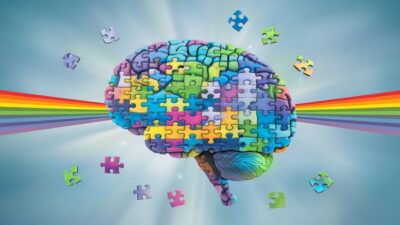PTSD is a challenging mental health condition that can develop after you've experienced or witnessed a traumatic event. You might notice intrusive memories, flashbacks, or nightmares about the trauma, along with strong urges to avoid anything that reminds you of the experience. Common symptoms include feeling disconnected from others, struggling with negative thoughts, and being easily startled or anxious. While PTSD can greatly impact your daily life, effective treatments like therapy, medication, and support groups can help you manage symptoms and heal. Understanding the condition's complexities is your first step toward finding the right path to recovery.
Understanding PTSD Symptoms

Combat veterans, assault survivors, and accident victims all share a common thread – their lives can be dramatically altered by Post-Traumatic Stress Disorder (PTSD). This complex condition affects millions of people worldwide, and understanding its symptoms is essential for both those experiencing them and their loved ones.
PTSD symptoms typically fall into four main categories that you might recognize. You'll often notice intrusive memories or flashbacks, where traumatic events replay in your mind without warning.
You may find yourself avoiding places, people, or activities that remind you of the trauma, which can seriously limit your daily life. Changes in your thoughts and mood might surface, leading you to feel disconnected from others or struggle with persistent negative emotions.
Physical and emotional reactions, like being easily startled or having trouble sleeping, can become part of your daily experience.
If you're experiencing these symptoms for more than a month after a traumatic event, it's important to know you're not alone. These responses are your brain's natural reaction to extreme stress, and with proper support and treatment, many people find relief from their PTSD symptoms.
Common Causes and Risk Factors
Beyond the widely recognized combat trauma, PTSD can develop from a broad spectrum of life-altering events. You might experience trauma and develop PTSD after surviving a natural disaster, facing a serious accident, or enduring physical or emotional abuse. Even witnessing something deeply distressing can trigger this condition.
Several factors can increase your risk of developing PTSD after experiencing trauma. If you've had previous mental health challenges, lack a strong support system, or have a family history of anxiety disorders, you're more likely to develop PTSD. Your brain's response to stress, combined with your genetic makeup, plays a significant role in determining how you'll process traumatic events.
The intensity and duration of the traumatic experience also matter. You're more vulnerable to PTSD if you've endured repeated trauma, like ongoing domestic violence, compared to a single incident.
Additionally, if you've experienced trauma during childhood, you may be more susceptible to developing PTSD later in life. Remember, it's not a sign of weakness – your response to trauma is influenced by complex biological and environmental factors.
Diagnosis and Assessment Methods

A mental health professional's accurate diagnosis of PTSD relies on several established assessment methods. When you're seeking post-traumatic stress disorder treatment, you'll typically undergo a thorough evaluation that includes both physical and psychological components, ensuring that other conditions aren't causing your symptoms.
Your healthcare provider will use these primary diagnostic tools to assess your condition:
- Clinical interviews where you'll discuss your traumatic experiences, symptoms, and their impact on your daily life in a safe, confidential setting.
- Standardized questionnaires and screening tools, such as the PCL-5 or CAPS-5, which measure symptom severity and frequency.
- Physical examinations to rule out medical conditions that might mimic PTSD symptoms, including blood tests and imaging if necessary.
- Behavioral observations during sessions, where professionals note your reactions, emotional responses, and coping mechanisms.
During your assessment, you'll need to be open about your experiences, though it's perfectly normal to feel uncomfortable. Your provider will work at your pace, understanding that discussing trauma isn't easy.
Treatment Options and Approaches
The treatment landscape for PTSD offers multiple evidence-based approaches that can help you manage symptoms and regain control of your life.
You'll find that psychotherapy, particularly Cognitive Behavioral Therapy (CBT) and Eye Movement Desensitization and Reprocessing (EMDR), stands at the forefront of effective treatments, helping you process trauma and develop healthy coping strategies.
Medication can play a vital role in your recovery, with antidepressants and anti-anxiety medications often prescribed to help manage symptoms.
You might benefit from combining these treatments with complementary approaches, such as mindfulness meditation, yoga, or art therapy, which can provide additional tools for healing.
Group therapy sessions offer you the chance to connect with others who've experienced similar traumas, while individual counseling helps you work through your specific challenges.
You'll learn practical PTSD coping strategies, including grounding techniques, breathing exercises, and stress management skills.
Your healthcare provider might also recommend lifestyle changes, such as regular exercise, proper sleep habits, and maintaining a support network, to complement your primary treatment plan and enhance your overall recovery journey.
Recovery and Support Systems

Building a strong support system forms the cornerstone of your PTSD recovery journey. When you're working through trauma, having people and resources you can rely on makes a significant difference in your healing process.
Engaging in creative expression through art therapy can also be an invaluable addition to your recovery, as it allows for the processing of emotions and trauma in a unique way the therapeutic tool of art therapy. You'll find that connecting with others who understand your experiences can help validate your feelings and provide practical coping strategies.
Your PTSD recovery plan should include multiple layers of support, ranging from professional help to personal connections.
Here's what you'll want to include in your support network:
- Mental health professionals who specialize in trauma and can guide your therapeutic progress
- Support groups, either in-person or online, where you can share experiences with others on similar recovery paths
- Trusted family members and friends who can offer emotional support and practical assistance when needed
- Community resources, including crisis hotlines and local organizations that understand PTSD



